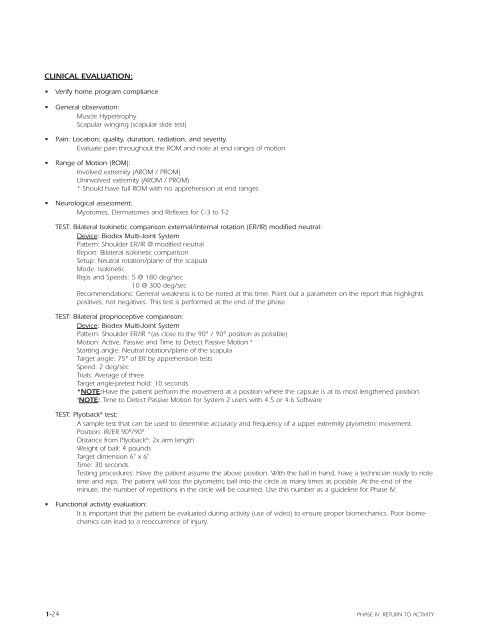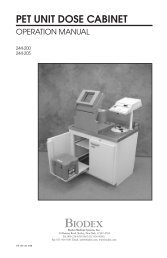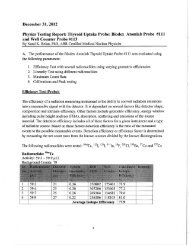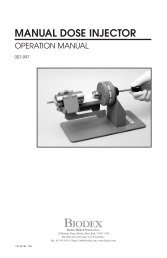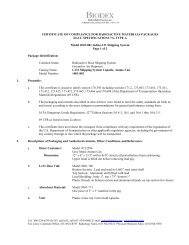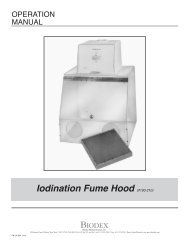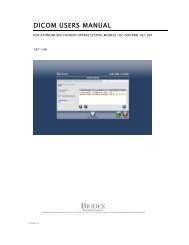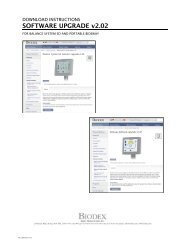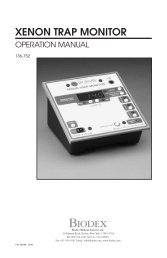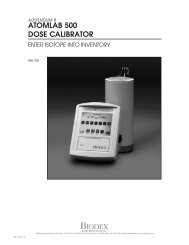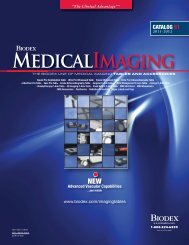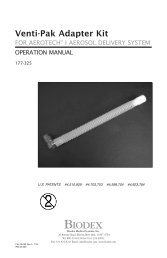Shoulder Dysfunction - Biodex
Shoulder Dysfunction - Biodex
Shoulder Dysfunction - Biodex
You also want an ePaper? Increase the reach of your titles
YUMPU automatically turns print PDFs into web optimized ePapers that Google loves.
CLINICAL EVALUATION:<br />
• Verify home program compliance<br />
• General observation:<br />
Muscle Hypertrophy<br />
Scapular winging (scapular slide test)<br />
• Pain: Location; quality, duration, radiation, and severity.<br />
Evaluate pain throughout the ROM and note at end ranges of motion<br />
• Range of Motion (ROM):<br />
Involved extremity (AROM / PROM)<br />
Uninvolved extremity (AROM / PROM)<br />
* Should have full ROM with no apprehension at end ranges<br />
• Neurological assessment:<br />
Myotomes, Dermatomes and Reflexes for C-3 to T-2<br />
TEST: Bilateral Isokinetic comparison external/internal rotation (ER/IR) modified neutral:<br />
Device: <strong>Biodex</strong> Multi-Joint System<br />
Pattern: <strong>Shoulder</strong> ER/IR @ modified neutral<br />
Report: Bilateral isokinetic comparison<br />
Setup: Neutral rotation/plane of the scapula<br />
Mode: Isokinetic<br />
Reps and Speeds: 5 @ 180 deg/sec<br />
10 @ 300 deg/sec<br />
Recommendations: General weakness is to be noted at this time. Point out a parameter on the report that highlights<br />
positives, not negatives. This test is performed at the end of the phase.<br />
TEST: Bilateral proprioceptive comparison:<br />
Device: <strong>Biodex</strong> Multi-Joint System<br />
Pattern: <strong>Shoulder</strong> ER/IR *(as close to the 90° / 90° position as possible)<br />
Motion: Active, Passive and Time to Detect Passive Motion #<br />
Starting angle: Neutral rotation/plane of the scapula<br />
Target angle: 75° of ER by apprehension tests<br />
Speed: 2 deg/sec<br />
Trials: Average of three<br />
Target angle-pretest hold: 10 seconds<br />
*NOTE:Have the patient perform the movement at a position where the capsule is at its most lengthened position.<br />
# NOTE: Time to Detect Passive Motion for System 2 users with 4.5 or 4.6 Software<br />
TEST: Plyoback ® test:<br />
A sample test that can be used to determine accuracy and frequency of a upper extremity plyometric movement.<br />
Position: IR/ER 90º/90º<br />
Distance from Plyoback ® : 2x arm length<br />
Weight of ball: 4 pounds<br />
Target dimension 6" x 6"<br />
Time: 30 seconds<br />
Testing procedures: Have the patient assume the above position. With the ball in hand, have a technician ready to note<br />
time and reps. The patient will toss the plyometric ball into the circle as many times as possible. At the end of the<br />
minute, the number of repetitions in the circle will be counted. Use this number as a guideline for Phase IV.<br />
• Functional activity evaluation:<br />
It is important that the patient be evaluated during activity (use of video) to ensure proper biomechanics. Poor biomechanics<br />
can lead to a reoccurrence of injury.<br />
1-24 PHASE IV: RETURN TO ACTIVITY


